Nvidia GeForce GTX 1050 & 1050 Ti Review
Power Consumption Results
Measurement Methodology & Graphical Illustration
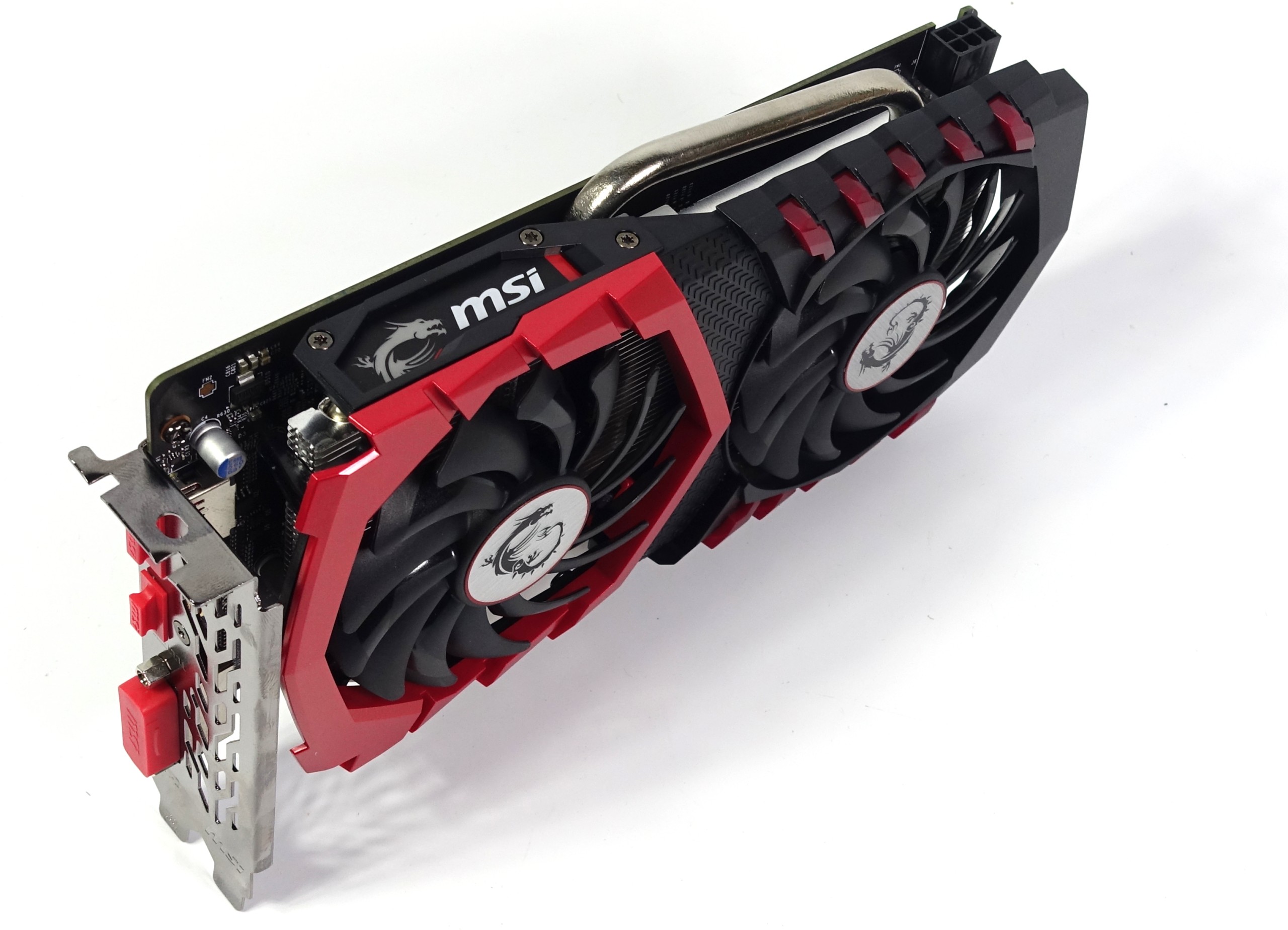
The measurement and analysis software we're gradually transitioning to, PresentMon, integrates a whole host of sensor data with the frame time measurements. We’re including the reader-friendly version of our oscillography measurement graphs as well, of course.
The measurement intervals are twice as long. There's also a hardware-based low-pass filter and software-based variable filter in place (the latter is a feature of the software used to analyze data; it's designed to evaluate the plausibility of very short load peaks and valleys). The resulting curves are a lot smoother than the old ones; we hope you derive more value from them as a result.
You'll find more information about our power consumption test methodology in The Math Behind GPU Power Consumption And PSUs.
You'll find a larger number of bar graphs, and higher-resolution versions of our power consumption charts that you can expand by clicking on them. We restructured our topic sections, added more comparison bar graphs, and, finally, added different scenarios to our measurements. In addition to power consumption, we also examine current to determine whether the graphics card stays within all of its relevant specifications. Our test equipment doesn't change, though:
| Power Consumption Measurement | |
|---|---|
| Test Method | Contact-free DC Measurement at PCIe Slot (Using a Riser Card) Contact-free DC Measurement at External Auxiliary Power Supply Cable Direct Voltage Measurement at Power Supply |
| Test Equipment | 2 x Rohde & Schwarz HMO 3054, 500MHz Digital Multi-Channel Oscilloscope with Storage Function 4 x Rohde & Schwarz HZO50 Current Probe (1 mA - 30 A, 100 kHz, DC) 4 x Rohde & Schwarz HZ355 (10:1 Probes, 500 MHz) 1 x Rohde & Schwarz HMC 8012 Digital Multimeter with Storage Function |
Power Consumption at Different Loads
In addition to our usual measurements, we're also including some additional games, rendering paths, and quality settings. With the sole exception of Metro: Last Light, resolution is being limited to 1920x1080. These entry-level graphics cards just aren’t meant for any more than that.
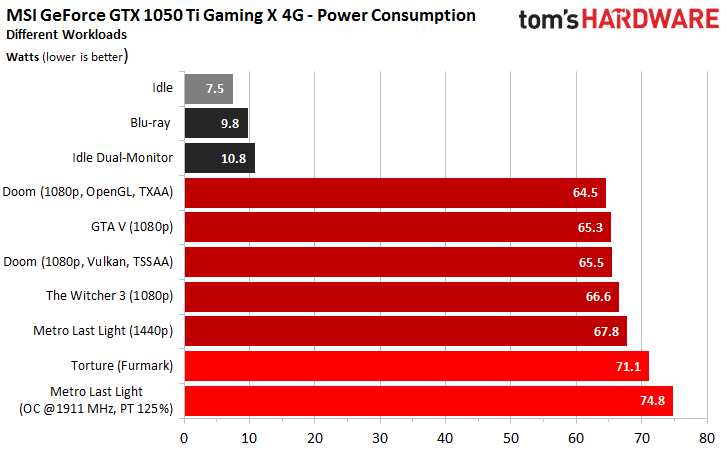
This time around, we're using the values from our highest sustainable overclock to represent peak power consumption (we went as high as 1911 MHz). Nvidia's 75 W power target didn't seem to be a limiting factor; we increased the target by 25% and didn't see consumption rise at all. In other words, the 1050 Ti hit its limit at that frequency.
Let’s take a look at how total power consumption evolves during the warm-up pass.
Get Tom's Hardware's best news and in-depth reviews, straight to your inbox.

It’s plain to see that consumption stays about the same, which tells us that there are no significant losses all the way up to the GeForce GTX 1050 Ti Gaming X 4 GB’s operating temperature.
Power Connector Load Distribution
Now we can examine power consumption more closely by looking at its distribution across two 12V rails (the motherboard slot and six-pin connector) during a realistic gaming load and a stress test.
Registering just 36 W during the stress test and 21 W while gaming, the motherboard slot is barely used. This is due to the fact that just one of the GPU power supply’s three phases (the memory modules) and the board components (fans and LED) draw from it. The other two GPU power supply phases are routed through the six-pin connector instead. And that's why MSI includes it. The 70 W that the GeForce GTX 1050 Ti Gaming X 4 GB draws at stock settings are already higher than the 66 W maximum you can see through the motherboard slot, according to the PCI-SIG’s specs.
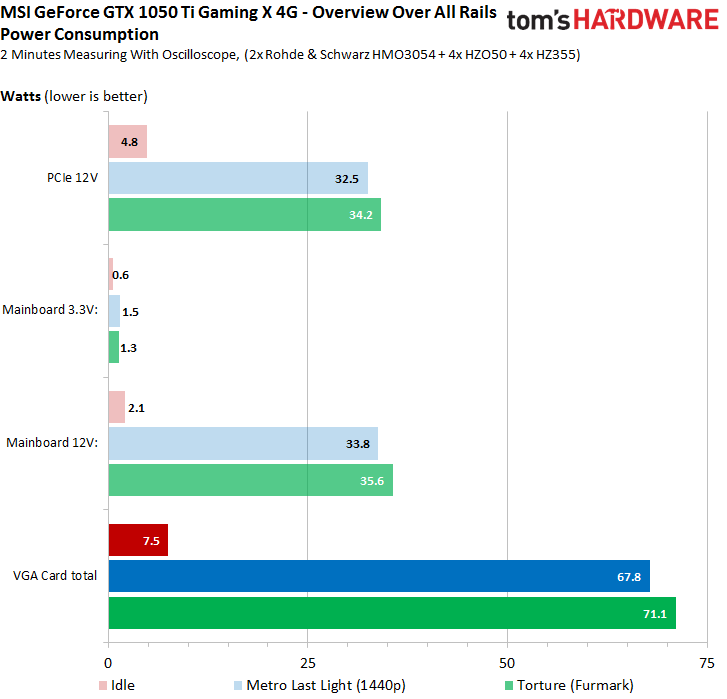
Here are the corresponding graphs for gaming and our stress test. Click on them for a larger version.


The PCI-SIG’s specifications only apply to current, meaning power consumption results on their own don't tell the whole story. Our readings put the motherboard slot well below 3 A. Given a ceiling of 5.5 A, the card has plenty of room to spare. This is hardly surprising in light of our low power consumption measurements for this connector. The 5.5 A figure would have been slightly exceeded if it wasn't for that six-pin connector, though.
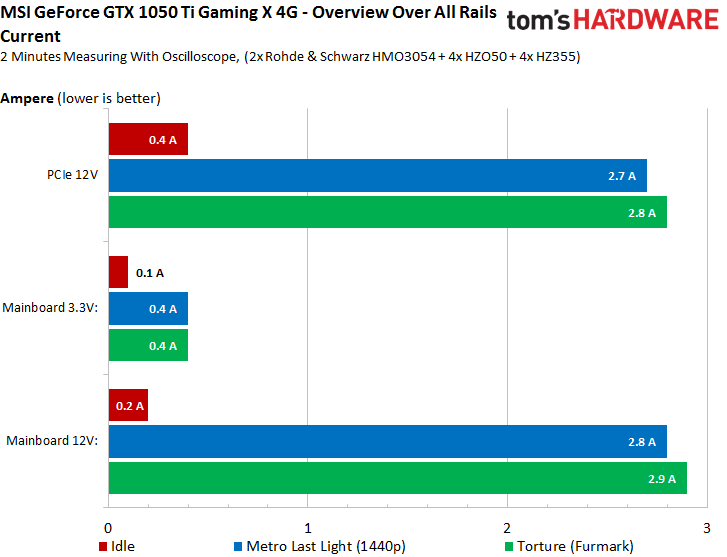
We also have larger graphs for the current measurements.
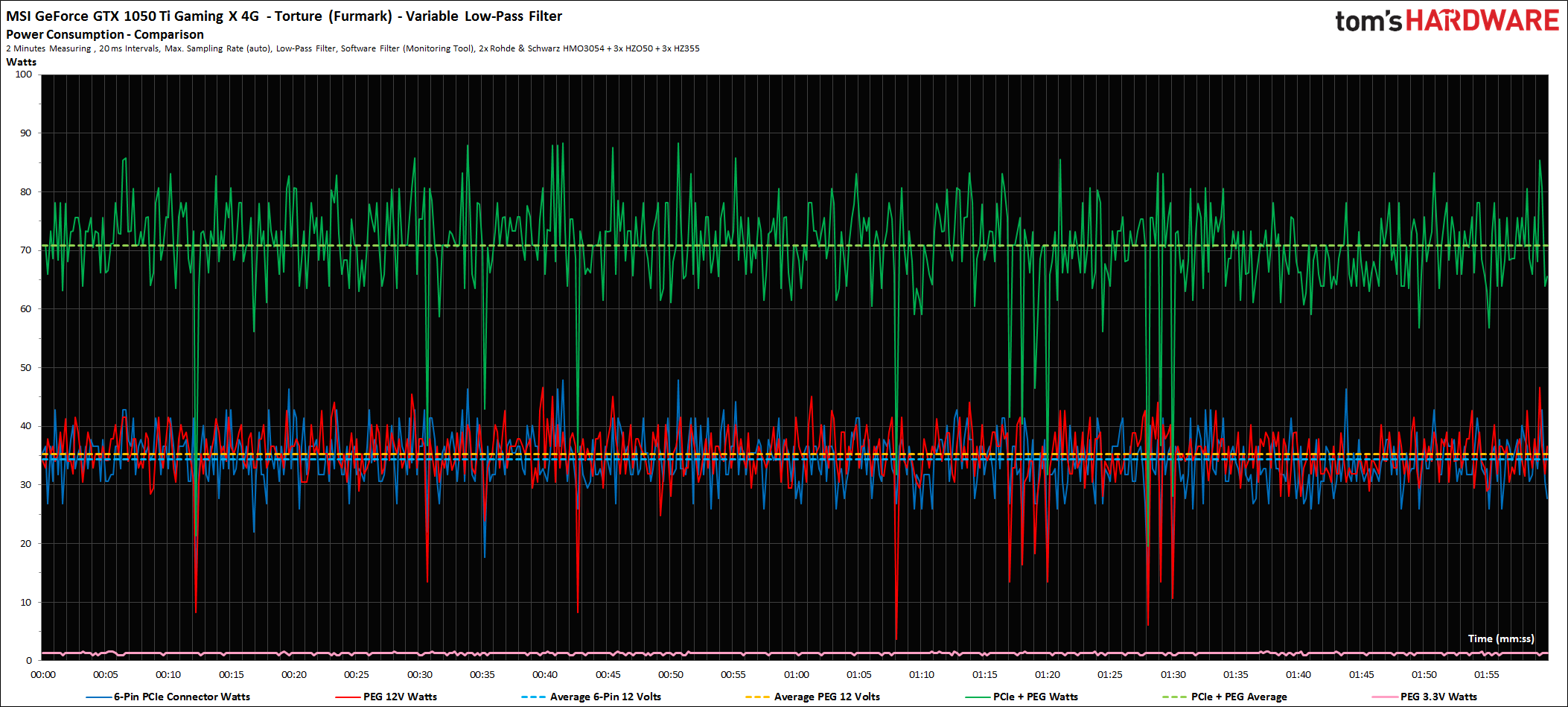
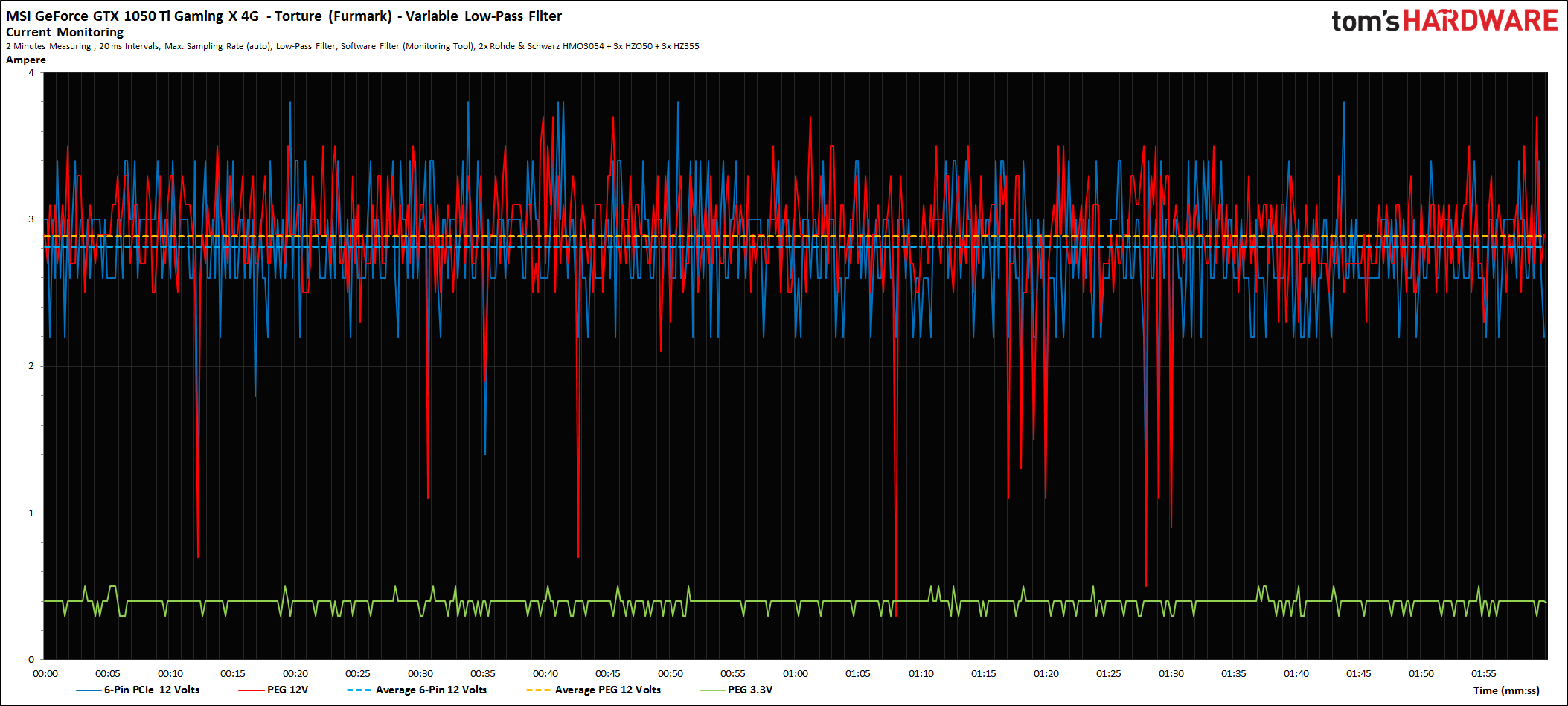
We would have loved to test GeForce GTX 1050 Ti and vanilla 1050 cards without power connectors as well, since those are the ones flirting with the motherboard slot's ceiling. But as we explained on page three, the launch sampling just wasn't what we hoped it'd be.
Power Consumption Comparison with Other Graphics Cards
Finally, we’d like to know how GeForce GTX 1050 Ti stacks up against other cards. We're using the peak power consumption numbers for this comparison because that's what we presented previously.

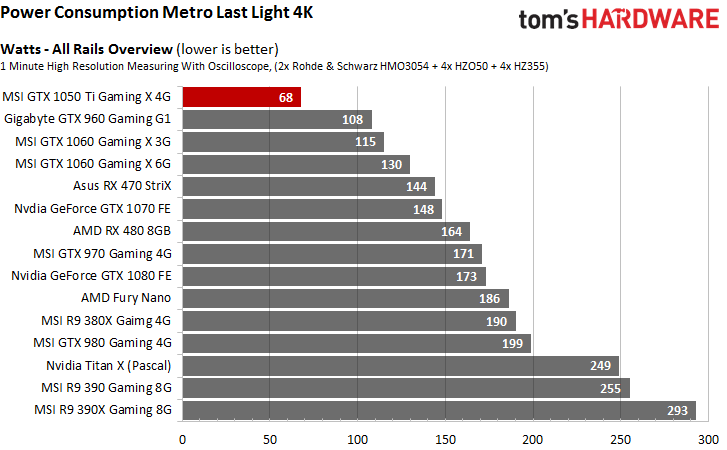

It’s interesting that GeForce GTX 1050 Ti Gaming X 4 GB has a high possible power target at 75 W plus 25%. However, it doesn’t use it. Due to the maximum stable clock frequency of 1911 MHz, the card starts throttling just under 75 W.
MORE: Best Graphics Cards
MORE: Desktop GPU Performance Hierarchy Table
MORE: All Graphics Content
Current page: Power Consumption Results
Prev Page Project CARS, StarCraft 2, The Witcher 3 & World of Warcraft Next Page Frequency, Temperature & Noise Results-
WildCard999 EVGA GTX 1050 ti around $150Reply
http://www.evga.com/Products/ProductList.aspx?type=0&family=GeForce+10+Series+Family&chipset=GTX+1050+Ti
EVGA GTX 1050 around $120
http://www.evga.com/Products/ProductList.aspx?type=0&family=GeForce+10+Series+Family&chipset=GTX+1050
It will probably be about $20-$30 more for the SSC & FTW versions. -
elbert Leaks suggested the 1050ti is as fast as the 960 and R9 280. I would love to have seen if that was true. My 280 is getting old and needs an upgrade. Any chance those can be added to the benchmarks?Reply -
tslot05qsljgo9ed Blind TrollReply
Zortac GTX 1050 Mini: $109.95
Zortac GTX 1050 Ti Mini: $139.95
http://www.newegg.com/Product/ProductList.aspx?Submit=ENE&IsNodeId=1&Description=1050&bop=And&SrchInDesc=zotac&Page=1&PageSize=36&order=BESTMATCH -
Corwin65 Reply18776894 said:Blind Troll
Zortac GTX 1050 Mini: $109.95
Zortac GTX 1050 Ti Mini: $139.95
http://www.newegg.com/Product/ProductList.aspx?Submit=ENE&IsNodeId=1&Description=1050&bop=And&SrchInDesc=zotac&Page=1&PageSize=36&order=BESTMATCH
If you're in the market snag one of those before prices jump. -
cdrkf @Elbert no way the 1050ti is going to best the 280, it's just not got enough resources behind it.Reply
You'd be far better looking at an RX 470 / 480 card or one of the 1060 cards imo. The only advantage to the 1050ti over your current card is lower power consumption, although the 280 isn't that bad anyhow. -
artk2219 All I am seeing is a nice pricewar brewing for the midrange segment. The RX 460 needs to drop to 90 to 95. and the 470 should ideally drop to 150 to 160. On Nvidias end the 1050 is just fine at 110, but the ti needs to drop to 130 to 135. Either way, i would save a little more and take a used R9 290 over any of them, but thats me. The only real reason to be crazy excited about the 1050, is if your limited to a single slot case and need a low power but decent performance card. In which case the 1050's are an excellent option, we really could use a nice single slot card.Reply -
spdragoo @Elbert: Didn't find direct comparisons to the R9 280, but Techspot's review showed benchmark comparisons to the R9 380 (which is pretty much on par with the 280):Reply
http://www.techspot.com/review/1269-nvidia-geforce-gtx-1050/
@CDRKF: Technically, you're correct: the GTX 1050Ti didn't (consistently) put in a better performance than the GTX 960 or R9 380. However, there were a couple of games that it beat them in (beating the 960 more often than the 380), & even when it didn't beat them its performance was right in the ballpark. To me, that says that either the 1050 or 1050Ti would make an excellent card for someone wanting to replace a broken R9 280/280 or GTX 960, but doesn't have the budget for a GTX 1060 or RX 470/480, & especially a good choice for someone whose system (*cough* OEM garbage *cough*) doesn't allow them to use a GPU that requires PCIe power connectors...as long as they're not expecting to game any higher than 1080p resolutions.
